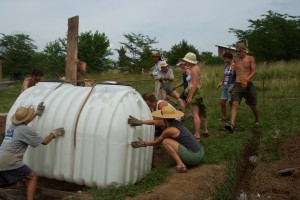Water Catchment at Dancing Rabbit
We are blessed here in northeast Missouri with generally abundant rainfall and other precipitation to meet our needs year-round. It arrives generally from the interior West, which has minimal industry and so leaves the rain nice and clean. In the midst of hundreds of surrounding miles of almost continuous conventional agriculture, it is not surprising that our local municipal water supply tests positive for various agrochemical constituents like AZT. Most of us try to avoid such unintentional additions to our diet, so to the greatest extent possible we catch and store rainfall adequate to meet our needs.
We have adopted and innovated a variety of technologies to meet these needs, which can be divided roughly into catchment and storage.
Catchment begins with systems to keep the rain as clean as possible en route to storage. Most structures at Dancing Rabbit employ steel roofing for this purpose, in addition to maximizing durability and avoiding petro-based asphalt shingles.
Next come gutters and downspouts. Gutters are fairly standard, but then come a series of diversions. One of the major innovations we’ve adopted here is the use of roof washers. A roof washer is essentially a stand pipe with a valve at its base, positioned so as to catch the first several gallons of rain that falls in a storm. This first wash carries a heavier load of leaves, dust and other detritus we don’t want to accumulate in our cisterns. Once it has filled, then subsequent drainage begins to flow over the roof washer and on to either a rain barrel or a cistern. After a rain event, the user empties the roof washer with the valve to prepare it for the next precipitation.
Rain barrels are extremely handy for everyday outdoor uses like watering garden beds, cleaning tools, slaking clay for construction, and so on. They usually employ 55 gallon food-grade polyethylene drums. Set upside down on an old spool or other stand, a few brass fittings, a short length of old hose and an on/off valve are all that is required to plumb the barrel. A hole cut in the former base of the barrel allows rain water to enter from above.
On our hillside location, it is often possible to siphon water from these barrels to other, similarly installed barrels in our garden for irrigation. Above-ground water storage should be emptied before hard-freezing weather sets in in winter to avoid damage to barrels and fittings.
 For larger quantity storage, where stored water is your only source, cisterns are essential, and have been in use for thousands of years. There are two basic types in operation at Dancing Rabbit: food-grade polyethylene, whose sizes can range up to 2000 gallons; and concrete, of which we currently have examples up to 14,000 gallons.
For larger quantity storage, where stored water is your only source, cisterns are essential, and have been in use for thousands of years. There are two basic types in operation at Dancing Rabbit: food-grade polyethylene, whose sizes can range up to 2000 gallons; and concrete, of which we currently have examples up to 14,000 gallons.
Plastic cisterns can be purchased online through various dealers, and can usually be had for about $1 per gallon of capacity. The use of plastic for this purpose can be a stretch for an ecovillager. However, in an underground application, where the tank will never experience UV degradation or the algal or other biological growth that might result from such exposure, a plastic cistern can be expected to last the lifetime of the building. Given the potential for groundwater contamination, its non-porous nature can also offer a sense of security to the homeowner. An essential step during installation is to anchor the cistern in its hole, or to weigh it down either by building a structure athwart it, or by never allowing it to go below 25% capacity. Failure to follow this precaution can lead to a cistern erupting out of the ground when the water level outside the tank significantly exceeds that inside.
Where larger storage capacity is required, concrete does the job. Most concrete cisterns at Dancing Rabbit follow the same rough pattern: excavate a large hole; in the base of the cavity, pour a concrete slab; carefully build concrete-block walls to an appropriate height, filling some wall cavities with rebar and concrete for additional strength; install in-flow, out-flow, and overflow plumbing; and pour a reinforced concrete slab for the cap, supporting it with concrete block pillars if necessary, and including a hatch to allow entry for maintenance. Waterproofing the walls, with multiple coats of appropriate compound on both interior and exterior surfaces, is an essential step to include. Ground water levels typically hover near the surface at wet times of year here, and concrete is a porous material that will eventually allow ground water to percolate through the walls without effective waterproofing.
Some concrete cisterns also include a partial dividing wall to allow for cleaning out one side while maintaining some water supply from the other; two plastic cisterns can serve the same function. Available roof area for rain catchment may be the biggest limitation to adequate supply in buildings with high water use. In these cases, additional flow from buildings that don’t employ water catchment may be possible to augment supplies.
Modes of access to stored water can range from fully manual hand-dipping, to hand-operated pumps, to electric pumps serving pressurized, on-demand, or gravity-flow water systems. A wide variety of pumps are available in both AC and DC models, including some whose power demands are suited to off-grid power systems.
